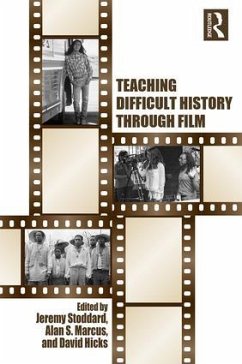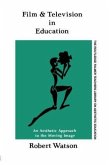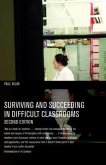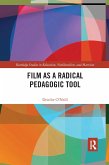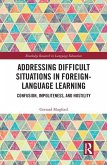- Broschiertes Buch
- Merkliste
- Auf die Merkliste
- Bewerten Bewerten
- Teilen
- Produkt teilen
- Produkterinnerung
- Produkterinnerung
Teaching Difficult History through Film explores the potential of film to engage young people in controversial or contested histories and how they are represented, ranging from gender and sexuality, to colonialism and slavery.
Andere Kunden interessierten sich auch für
![Teaching and Learning the Difficult Past Teaching and Learning the Difficult Past]() Teaching and Learning the Difficult Past54,99 €
Teaching and Learning the Difficult Past54,99 €![Film And Television In Education Film And Television In Education]() Robert WatsonFilm And Television In Education63,99 €
Robert WatsonFilm And Television In Education63,99 €![Surviving and Succeeding in Difficult Classrooms Surviving and Succeeding in Difficult Classrooms]() Paul BlumSurviving and Succeeding in Difficult Classrooms44,99 €
Paul BlumSurviving and Succeeding in Difficult Classrooms44,99 €![Film as a Radical Pedagogic Tool Film as a Radical Pedagogic Tool]() Deirdre O'NeillFilm as a Radical Pedagogic Tool54,99 €
Deirdre O'NeillFilm as a Radical Pedagogic Tool54,99 €![Film Education in Secondary Schools (1983) Film Education in Secondary Schools (1983)]() Joan Driscoll LynchFilm Education in Secondary Schools (1983)51,99 €
Joan Driscoll LynchFilm Education in Secondary Schools (1983)51,99 €![Addressing Difficult Situations in Foreign-Language Learning Addressing Difficult Situations in Foreign-Language Learning]() Gerrard MugfordAddressing Difficult Situations in Foreign-Language Learning54,99 €
Gerrard MugfordAddressing Difficult Situations in Foreign-Language Learning54,99 €![Introducing Difficult Mathematics Topics in the Elementary Classroom Introducing Difficult Mathematics Topics in the Elementary Classroom]() Francis J. GardellaIntroducing Difficult Mathematics Topics in the Elementary Classroom53,99 €
Francis J. GardellaIntroducing Difficult Mathematics Topics in the Elementary Classroom53,99 €-
-
-
Teaching Difficult History through Film explores the potential of film to engage young people in controversial or contested histories and how they are represented, ranging from gender and sexuality, to colonialism and slavery.
Produktdetails
- Produktdetails
- Verlag: Routledge
- Seitenzahl: 274
- Erscheinungstermin: 15. Juni 2017
- Englisch
- Abmessung: 229mm x 152mm x 15mm
- Gewicht: 402g
- ISBN-13: 9781138190771
- ISBN-10: 1138190772
- Artikelnr.: 48211983
- Herstellerkennzeichnung
- Libri GmbH
- Europaallee 1
- 36244 Bad Hersfeld
- gpsr@libri.de
- Verlag: Routledge
- Seitenzahl: 274
- Erscheinungstermin: 15. Juni 2017
- Englisch
- Abmessung: 229mm x 152mm x 15mm
- Gewicht: 402g
- ISBN-13: 9781138190771
- ISBN-10: 1138190772
- Artikelnr.: 48211983
- Herstellerkennzeichnung
- Libri GmbH
- Europaallee 1
- 36244 Bad Hersfeld
- gpsr@libri.de
Jeremy Stoddard is Professor of Education and an Associated Faculty Member in the Film and Media Studies program at The College of William & Mary. Alan S. Marcus is Associate Professor in the Department of Curriculum and Instruction at the Neag School of Education, University of Connecticut. David Hicks is Professor of History and Social Science Education (Social Studies) in the School of Education at Virginia Tech.
Dedications
Section 1: Introduction to Teaching Difficult History and Film as Difficult
History
Chapter 1: Using Film to Teach Difficult Histories
Jeremy Stoddard, Alan S. Marcus, and David Hicks
Chapter 2: Difficult History Means Difficult Questions: Using Film to
Reveal the Perspective of 'The Other' in Difficult History Topics
Ben Walsh, David Hicks, and Stephanie van Hover
Section 2: Human Rights, Trauma, and Contemporary Difficult Histories
Chapter 3: Teaching the History and Contemporary Challenge of Human Rights
through Film
Glenn Mitoma
Chapter 4: From Seeing to Learn to Learning to See: Films on the
Palestinian-Israeli Conflict
Brian Britt
Chapter 5: The Torturers Among Us: History, the Film Industry, and its
Claims to Truth
Robert P. Stephens
Section 3: Difficult History, Identity, and Implementation in Curriculum
Chapter 6: Institutional Roles in Using Film to Teach Difficult History:
The Federal Agency for Civic Education and The Lives of Others
Mattias Frey
Chapter 7: "I saw a REAL Indian on TV last night!": Engaging Students in
Historical Thinking for Social Justice
Christine Rogers Stanton, Amanda LeClair-Diaz, Brad Hall, and Lucia
Ricciardelli
Chapter 8: What Does History Have to Do With This?: Youth Filmmaking for
Social Change
Sandra Quiñones, Brian Bailey, Joseph Ehman, and Daniel Delehanty
Section 4: Teaching Common but Difficult Histories through Film
Chapter 9: Hollywood Histories: Examining Contemporary Depictions of Race
and American Slavery in Popular Film
Keffrelyn D. Brown and Anthony L. Brown
Chapter 10: Classroom as Memory Workspace: The Educational and Empathetic
Potentials of Twelve Years a Slave and Ask a Slave
Matthew R. Cook and Derek H. Alderman
Chapter 11: Teaching Difficult History with Film: Multiple Perspectives on
the Holocaust
Alan S. Marcus and Gary Mills
Section 5: Difficult Histories from the Margins in Curriculum and Teacher
Education
Chapter 12: Questioning "Normal": Actively Undoing Dis/ability Stereotypes
Through Teaching a Critical Analysis of Films.
David J. Connor
Chapter 13: Invoking Precious Knowledge with Teacher Candidates to Reclaim
the Past, Reassess the Present, and Revolutionize Future Practice
Mark Kohan and Emilie M. Camp
Chapter 14: Finally "Seeing" a Queer Past: The Importance of Film in
Teaching LGBTQ American History
Sharon Ullman
Section 1: Introduction to Teaching Difficult History and Film as Difficult
History
Chapter 1: Using Film to Teach Difficult Histories
Jeremy Stoddard, Alan S. Marcus, and David Hicks
Chapter 2: Difficult History Means Difficult Questions: Using Film to
Reveal the Perspective of 'The Other' in Difficult History Topics
Ben Walsh, David Hicks, and Stephanie van Hover
Section 2: Human Rights, Trauma, and Contemporary Difficult Histories
Chapter 3: Teaching the History and Contemporary Challenge of Human Rights
through Film
Glenn Mitoma
Chapter 4: From Seeing to Learn to Learning to See: Films on the
Palestinian-Israeli Conflict
Brian Britt
Chapter 5: The Torturers Among Us: History, the Film Industry, and its
Claims to Truth
Robert P. Stephens
Section 3: Difficult History, Identity, and Implementation in Curriculum
Chapter 6: Institutional Roles in Using Film to Teach Difficult History:
The Federal Agency for Civic Education and The Lives of Others
Mattias Frey
Chapter 7: "I saw a REAL Indian on TV last night!": Engaging Students in
Historical Thinking for Social Justice
Christine Rogers Stanton, Amanda LeClair-Diaz, Brad Hall, and Lucia
Ricciardelli
Chapter 8: What Does History Have to Do With This?: Youth Filmmaking for
Social Change
Sandra Quiñones, Brian Bailey, Joseph Ehman, and Daniel Delehanty
Section 4: Teaching Common but Difficult Histories through Film
Chapter 9: Hollywood Histories: Examining Contemporary Depictions of Race
and American Slavery in Popular Film
Keffrelyn D. Brown and Anthony L. Brown
Chapter 10: Classroom as Memory Workspace: The Educational and Empathetic
Potentials of Twelve Years a Slave and Ask a Slave
Matthew R. Cook and Derek H. Alderman
Chapter 11: Teaching Difficult History with Film: Multiple Perspectives on
the Holocaust
Alan S. Marcus and Gary Mills
Section 5: Difficult Histories from the Margins in Curriculum and Teacher
Education
Chapter 12: Questioning "Normal": Actively Undoing Dis/ability Stereotypes
Through Teaching a Critical Analysis of Films.
David J. Connor
Chapter 13: Invoking Precious Knowledge with Teacher Candidates to Reclaim
the Past, Reassess the Present, and Revolutionize Future Practice
Mark Kohan and Emilie M. Camp
Chapter 14: Finally "Seeing" a Queer Past: The Importance of Film in
Teaching LGBTQ American History
Sharon Ullman
Dedications
Section 1: Introduction to Teaching Difficult History and Film as Difficult
History
Chapter 1: Using Film to Teach Difficult Histories
Jeremy Stoddard, Alan S. Marcus, and David Hicks
Chapter 2: Difficult History Means Difficult Questions: Using Film to
Reveal the Perspective of 'The Other' in Difficult History Topics
Ben Walsh, David Hicks, and Stephanie van Hover
Section 2: Human Rights, Trauma, and Contemporary Difficult Histories
Chapter 3: Teaching the History and Contemporary Challenge of Human Rights
through Film
Glenn Mitoma
Chapter 4: From Seeing to Learn to Learning to See: Films on the
Palestinian-Israeli Conflict
Brian Britt
Chapter 5: The Torturers Among Us: History, the Film Industry, and its
Claims to Truth
Robert P. Stephens
Section 3: Difficult History, Identity, and Implementation in Curriculum
Chapter 6: Institutional Roles in Using Film to Teach Difficult History:
The Federal Agency for Civic Education and The Lives of Others
Mattias Frey
Chapter 7: "I saw a REAL Indian on TV last night!": Engaging Students in
Historical Thinking for Social Justice
Christine Rogers Stanton, Amanda LeClair-Diaz, Brad Hall, and Lucia
Ricciardelli
Chapter 8: What Does History Have to Do With This?: Youth Filmmaking for
Social Change
Sandra Quiñones, Brian Bailey, Joseph Ehman, and Daniel Delehanty
Section 4: Teaching Common but Difficult Histories through Film
Chapter 9: Hollywood Histories: Examining Contemporary Depictions of Race
and American Slavery in Popular Film
Keffrelyn D. Brown and Anthony L. Brown
Chapter 10: Classroom as Memory Workspace: The Educational and Empathetic
Potentials of Twelve Years a Slave and Ask a Slave
Matthew R. Cook and Derek H. Alderman
Chapter 11: Teaching Difficult History with Film: Multiple Perspectives on
the Holocaust
Alan S. Marcus and Gary Mills
Section 5: Difficult Histories from the Margins in Curriculum and Teacher
Education
Chapter 12: Questioning "Normal": Actively Undoing Dis/ability Stereotypes
Through Teaching a Critical Analysis of Films.
David J. Connor
Chapter 13: Invoking Precious Knowledge with Teacher Candidates to Reclaim
the Past, Reassess the Present, and Revolutionize Future Practice
Mark Kohan and Emilie M. Camp
Chapter 14: Finally "Seeing" a Queer Past: The Importance of Film in
Teaching LGBTQ American History
Sharon Ullman
Section 1: Introduction to Teaching Difficult History and Film as Difficult
History
Chapter 1: Using Film to Teach Difficult Histories
Jeremy Stoddard, Alan S. Marcus, and David Hicks
Chapter 2: Difficult History Means Difficult Questions: Using Film to
Reveal the Perspective of 'The Other' in Difficult History Topics
Ben Walsh, David Hicks, and Stephanie van Hover
Section 2: Human Rights, Trauma, and Contemporary Difficult Histories
Chapter 3: Teaching the History and Contemporary Challenge of Human Rights
through Film
Glenn Mitoma
Chapter 4: From Seeing to Learn to Learning to See: Films on the
Palestinian-Israeli Conflict
Brian Britt
Chapter 5: The Torturers Among Us: History, the Film Industry, and its
Claims to Truth
Robert P. Stephens
Section 3: Difficult History, Identity, and Implementation in Curriculum
Chapter 6: Institutional Roles in Using Film to Teach Difficult History:
The Federal Agency for Civic Education and The Lives of Others
Mattias Frey
Chapter 7: "I saw a REAL Indian on TV last night!": Engaging Students in
Historical Thinking for Social Justice
Christine Rogers Stanton, Amanda LeClair-Diaz, Brad Hall, and Lucia
Ricciardelli
Chapter 8: What Does History Have to Do With This?: Youth Filmmaking for
Social Change
Sandra Quiñones, Brian Bailey, Joseph Ehman, and Daniel Delehanty
Section 4: Teaching Common but Difficult Histories through Film
Chapter 9: Hollywood Histories: Examining Contemporary Depictions of Race
and American Slavery in Popular Film
Keffrelyn D. Brown and Anthony L. Brown
Chapter 10: Classroom as Memory Workspace: The Educational and Empathetic
Potentials of Twelve Years a Slave and Ask a Slave
Matthew R. Cook and Derek H. Alderman
Chapter 11: Teaching Difficult History with Film: Multiple Perspectives on
the Holocaust
Alan S. Marcus and Gary Mills
Section 5: Difficult Histories from the Margins in Curriculum and Teacher
Education
Chapter 12: Questioning "Normal": Actively Undoing Dis/ability Stereotypes
Through Teaching a Critical Analysis of Films.
David J. Connor
Chapter 13: Invoking Precious Knowledge with Teacher Candidates to Reclaim
the Past, Reassess the Present, and Revolutionize Future Practice
Mark Kohan and Emilie M. Camp
Chapter 14: Finally "Seeing" a Queer Past: The Importance of Film in
Teaching LGBTQ American History
Sharon Ullman

